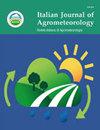Predicting symptoms of downy mildew, powdery mildew, and gray mold diseases of grapevine through machine learning
IF 0.8
4区 农林科学
Q2 AGRONOMY
Italian Journal of Agrometeorology-Rivista Italiana Di Agrometeorologia
Pub Date : 2021-12-27
DOI:10.36253/ijam-1131
引用次数: 5
Abstract
Downy mildew, powdery mildew, and gray mold are major diseases of grapevine with a strong negative impact on fruit yield and fruit quality. These diseases are controlled by the application of chemicals, which may cause undesirable effects on the environment and on human health. Thus, monitoring and forecasting crop disease is essential to support integrated pest management (IPM) measures. In this study, two tree-based machine learning (ML) algorithms, random forest and C5.0, were compared to test their capability to predict the appearance of symptoms of grapevine diseases, considering meteorological conditions, spatial indices, the number of crop protection treatments and the frequency of monitoring days in which symptoms were recorded in the previous year. Data collected in Tuscany region (Italy), on the presence of symptoms on grapevine, from 2006 to 2017 were divided with an 80/20 proportion in training and test set, data collected in 2018 and 2019 were tested as independent years for downy mildew and powdery mildew. The frequency of symptoms in the previous year and the cumulative precipitation from April to seven days before the monitoring day were the most important variables among those considered in the analysis for predicting the occurrence of disease symptoms. The best performance in predicting the presence of symptoms of the three diseases was obtained with the algorithm C5.0 by applying (i) a technique to deal with imbalanced dataset (i.e., symptoms were detected in the minority of observations) and (ii) an optimized cut-off for predictions. The balanced accuracy achieved in the test set was 0.8 for downy mildew, 0.7 for powdery mildew and 0.9 for gray mold. The application of the models for downy mildew and powdery mildew in the two independent years (2018 and 2019) achieved a lower balanced accuracy, around 0.7 for both the diseases. Machine learning models were able to select the best predictors and to unravel the complex relationships among geographic indices, bioclimatic indices, protection treatments and the frequency of symptoms in the previous year.通过机器学习预测葡萄霜霉病、白粉病和灰霉病的症状
霜霉病、白粉病和灰霉病是葡萄的主要病害,对果实产量和品质有较大的负面影响。这些疾病是通过使用化学品来控制的,但化学品可能对环境和人类健康造成不良影响。因此,监测和预报作物病害对于支持病虫害综合治理(IPM)措施至关重要。在本研究中,比较了两种基于树木的机器学习(ML)算法——随机森林算法和C5.0算法,在考虑气象条件、空间指数、作物保护处理次数和上一年记录症状的监测天数的情况下,测试了它们预测葡萄病害症状出现的能力。在意大利托斯卡纳地区收集的2006年至2017年葡萄藤出现症状的数据在训练集和测试集中按80/20的比例进行划分,2018年和2019年收集的数据作为霜霉病和白粉病的独立年份进行测试。在预测疾病症状发生的分析中,前一年的症状频次和4月至监测日前7天的累计降水量是最重要的变量。通过应用(i)处理不平衡数据集的技术(即在少数观察值中检测到症状)和(ii)优化的预测截止值,C5.0算法在预测三种疾病的症状存在方面获得了最佳性能。测试集的平衡精度为霜霉0.8,白粉病0.7,灰霉0.9。霜霉病和白粉病模型在两个独立年份(2018年和2019年)的应用取得了较低的平衡精度,两种疾病的平衡精度都在0.7左右。机器学习模型能够选择最佳预测因子,并揭示上一年的地理指数、生物气候指数、保护治疗和症状频率之间的复杂关系。
本文章由计算机程序翻译,如有差异,请以英文原文为准。
求助全文
约1分钟内获得全文
求助全文
来源期刊

Italian Journal of Agrometeorology-Rivista Italiana Di Agrometeorologia
AGRONOMY-ENVIRONMENTAL SCIENCES
CiteScore
2.10
自引率
8.30%
发文量
6
期刊介绍:
Among the areas of specific interest of the journal there are: ecophysiology; phenology; plant growth, quality and quantity of production; plant pathology; entomology; welfare conditions of livestocks; soil physics and hydrology; micrometeorology; modeling, simulation and forecasting; remote sensing; territorial planning; geographical information systems and spatialization techniques; instrumentation to measure physical and biological quantities; data validation techniques, agroclimatology; agriculture scientific dissemination; support services for farmers.
 求助内容:
求助内容: 应助结果提醒方式:
应助结果提醒方式:


